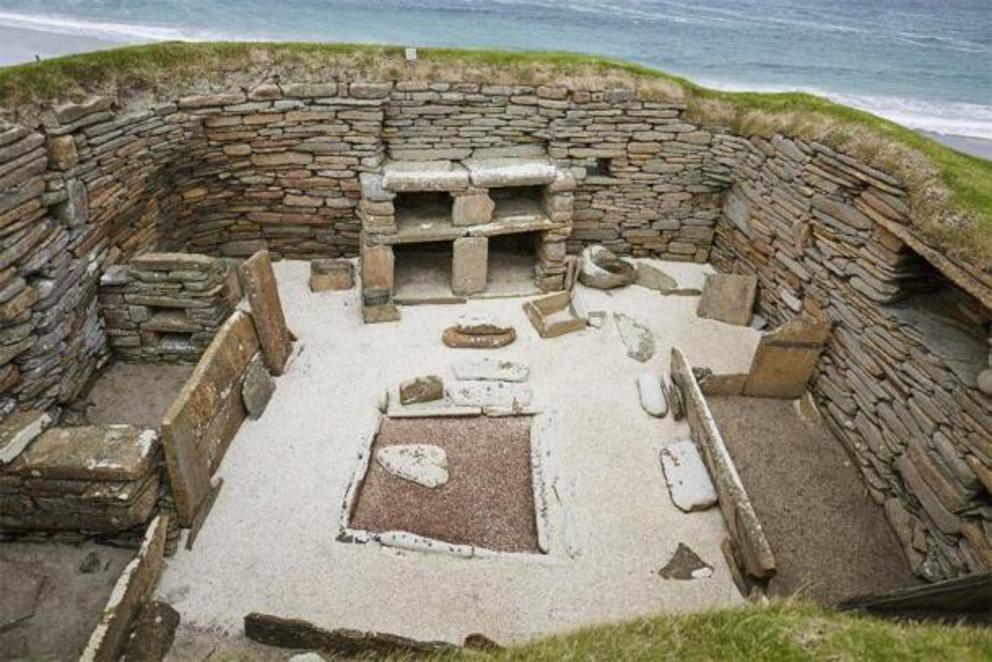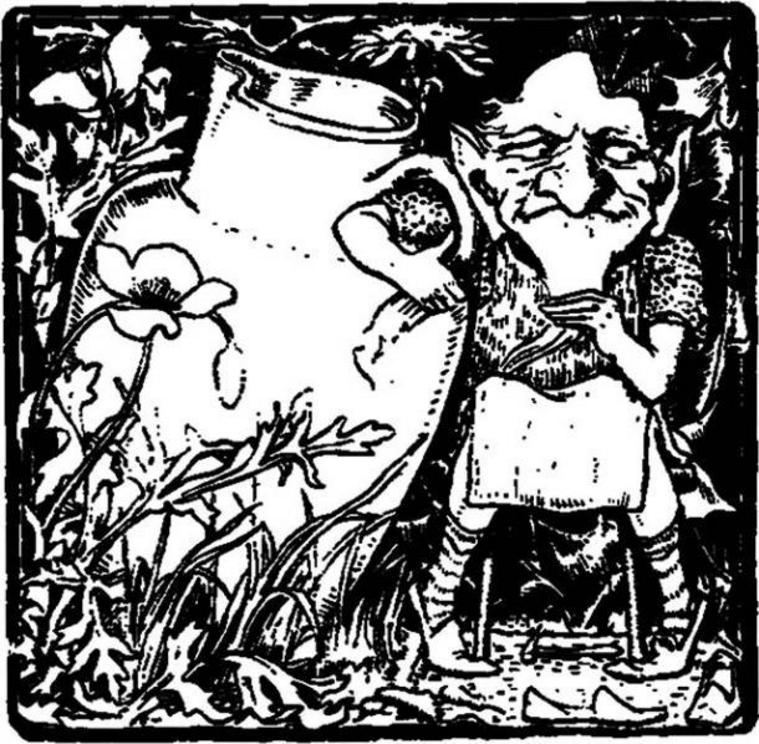Hard evidence of Neolithic little people in Scotland, Hawaii, Indonesia…
Top image: For most of us little people bring to mind images of colorful dwarves but in archaeological terms little people refer to a wide range of sophisticated Neolithic peoples found literally all over the world!
From the lush, foggy hills rolling through the Scottish Isles, to the primordial peaks of glorious Hawaii, and all the way across the globe to the wild rainforests of Indonesia, evidence of a “little people” dwarf species is emerging from the depths of prehistory. It’s difficult to decipher the difference between myth, legend, folklore, and historical fact when objectively delving into these island dwelling short people. The easy way out is to hop onto the rigid, biased academic bandwagon and belittle such concepts as nothing more than ancient fiction, but this position is textbook flawed reasoning. When these ancient accounts of ancient little people are approached with true objectivity, a peculiar pattern presents itself.
Skara Brae: The Neolithic Little People Of The Orkneys
Skara Brae is a small cluster of very strange ancient stone dwellings found on the Scottish Orkney archipelago, and the only thing stranger than the ruins themselves are their suspicious treatment by archaeologists. Originally, these eight Neolithic houses were subterranean, hidden beneath a mysterious mound that was wiped away by a violent storm in 1850 AD. Eighteen years later, the first amateur excavation occurred, after which, the ruins were abandoned. Then the site was allegedly looted of many artifacts in 1913 AD, and it was not “officially” studied until 1927 AD by the University of Edinburgh. Professor Gordon Childe came to the feeble conclusion that this site dated to 500 BC, but this was obviously incorrect and in the seventies material from the site was carbon dated to 3180 BC.
 One of the Skara Brae locations showing evidence of little people based on the size of the stone furniture found there.
One of the Skara Brae locations showing evidence of little people based on the size of the stone furniture found there.
Skara Brae: Little People Enigmas And Controversies
These eight little dwellings came complete with stone beds, a central hearth, shell midden insulation, and indoor toilets draining outwards from the structures, but most interesting of all, are the dimensions of the doors and beds. The doorways and beds barely reach four feet (1.2 meters), and so, the only logical conclusion to make from these dimensions is that the inhabitants were indeed diminutive in stature, in other words, these were little folk living underground.
This fascinating oddity is deliberately overlooked by the academics who have also managed to neglect and misplace precious artifacts over nearly two centuries of haphazard excavations and biased studies. Equally enigmatic is the inescapable fact that these dwellings were suddenly abandoned. These wee inhabitants seem to have been in a terrible rush to flee their homes, vanishing into history leaving behind all manner of possessions. For example, stone spheres equal in weight and circumference, with three dimensional designs on them, and whose purpose is a complete mystery.
Orkney Little People Megalithic Sites Are Interlinked!
Skara Brae is one of a related group of anomalous sites now designated collectively as the Heart of Neolithic Orkney World Heritage Site. The Standing Stones of Stenness are a nearby collection of twelve enormous standing stones nearly twenty-feet tall (six meters) with a central hearth stone. This ancient henge predates Stonehenge, and there is a growing consensus, even among mainstream scholars, that this is the oldest henge in Britain. The Ring of Brodgar is another spellbinding site within the Neolithic cluster. This site contains an astonishing thirteen artificial mounds (not properly excavated) alongside thirty to sixty more gigantic standing stones, all astronomically aligned. The final site in this anomalous cluster is Maeshowe, a supposed burial chamber/mound, containing massive stones, and aboriginal runic inscriptions . And all these sites are connected by a series of “low roads” which proves beyond any doubt they were built by the same dwarfish little people who inhabited Skara Brae.
 One of the few images of a Clurichaun, who are the Neolithic little people of mainland Scotland.
One of the few images of a Clurichaun, who are the Neolithic little people of mainland Scotland.
Little People Terms: Trows, Trolls, Dwarves, And Clurichauns
Certain regions are world famous for their concentrated cultural beliefs regarding ancient races of little people, who often possessed supernatural abilities, a mischievous disposition, and guarded hoards of treasure.
Ireland (also home to megalithic mysteries similar to those of the Orkneys) is probably the most notorious of regions for harboring the iconic Leprechaun tradition, and close behind is Iceland, whose modern citizens are often ridiculed for their persistent beliefs in the existence of an ancient race of little people.
The Scottish Trow for instance, are a nocturnal race of diminutive, hairy, and typically malevolent hominins that loved music and kidnapping Homo sapiens. They lived in “trowie knowes” which are earthen mound dwellings. This tradition is virtually identical to the Scandinavian belief in dwarves, trolls, or elves. And the Scottish Clurichauns are essentially the same as the Irish Leprechauns sharing with them their small size, heavy drinking, and treasure hoarding habits. It is worth noting that processed barley was discovered within the ruins of Skara Brae, which can be interpreted to mean that these little people were drinkers from early on.
 A statue of a Menehune guardian at the Hilton Hawaiian Village that clearly proves a belief in these little people since ancient times.
A statue of a Menehune guardian at the Hilton Hawaiian Village that clearly proves a belief in these little people since ancient times.
The Menehune: The Little People Of Hawaii
Deep in the dark blue heart of the Pacific Ocean, on the sublime islands of Hawaii, a similar pattern of little people beliefs also exists. And the extreme remoteness and distance of this location proves that the little people theory is not a case of cultural conflation.
In the Hawaiian tradition, the Menehune are described as an ethnic group of dwarf people who were nocturnal, master craftsman, and responsible for building many of the artificial fishing ponds and platform temples that dot the islands. Another crucial aspect of this tradition is the insistence of the Hawaiian people that the Menehune predated the arrival of their Polynesian ancestors and were driven away upon their arrival.
The Menehune fishponds and platform temples are not primitive creations. There are approximately 360 fishponds and two-dozen temples attributed to these little people and all of them show evidence of highly sophisticated construction methods. For example, some of the ponds have sluice gates designed to channel nutrient rich seawater and small fish through the porous lava rock/coral walls, allowing for algae cultivation: essentially an advanced self-sustaining fish husbandry/aquaculture system.
Legends Of The Menehune Little People
Conventional academics and so-called scholars often attempt to explain away the Menehune as either an antiquated caste system (regarding the Menehune as figuratively diminutive i.e., commoners) or as projected imports of European folklore. However, this dismissal has been easily debunked as many of the fishponds and landmarks bear names relating to the Menehune, confirming their existence in a longstanding oral tradition. This oral tradition holds that the Menehune would come out at twilight singing and chanting as they worked on their building projects, which if they did not finish in a single night would remain incomplete. It was also said that they were fond of bananas, fish, and would remain hidden from Homo sapiens with the rare exception being children, who would occasionally see them only to be met with disbelief from their elders.
Hawaiian Archaeology Or The Lack Thereof
There are very few, if any, thorough, in-depth archaeological studies exploring the ancient history of the islands of Hawaii. This is no doubt partially due to continuing tensions between the indigenous population and the modern Western World. The Hawaiians are a proud and fearless people who consider themselves a sovereign state and generally consider the American presence unjust. Unfortunately, this mild yet fundamental tension is a major factor in the lack of archaeological pursuits on the islands, particularly those involving sacred sites or archaic human remains. However, despite these tensions, one very obscure artifact has managed to be discovered that is directly related to the “little people” pattern of the Orkneys: mysterious, basically perfect stone spheres.
 An artist's impression of what an Orang Pendek little person might look like, which in this case is more primate that humanoid.
An artist's impression of what an Orang Pendek little person might look like, which in this case is more primate that humanoid.
Orang Pendek: The Elusive Little People Of Indonesia
Across yet another vast swath of ocean, in the sweltering rainforests of Indonesia, the little people pattern is repeated. Orang Pendek , literally translated from Indonesian as “short person,” are a legendary, small, and hairy species of human hiding away deep in the forests of Sumatra. For over a century, reports have been made by locals, Dutch settlers, and scientists all claiming to have seen what is variously described as a little people.
Perhaps the most infamous of all such reports comes from Dutch colonist Van Heerwarden who claimed to glimpse an Orang Pendek little person while surveying on Sumatra in 1923 AD. He wrote: “I discovered a dark and hairy creature on a branch… The sedapa was also hairy on the front of its body; the color was a little lighter on the back. The very dark hair on its head fell to just below the shoulder blades or even almost to the waist… Had it been standing, its arms would have reached to a little above its knees; they were therefore long, but its legs seemed to me rather short. I did not see its feet, but I did see some toes which were shaped in a very normal manner… There was nothing repulsive or ugly about its face, nor was it at all apelike.”
Evidence Of Obscure Indonesian Megalithic Sites
Indonesia does not immediately jump to mind as a location rich with Neolithic/Megalithic sites, but it does indeed contain ancient stone sites that rival the most mysterious in all the world. Lore Lindu National Park, on the island of Sulawesi, is one such site. The site is classified as a UNESCO Biosphere Preserve, which in it of itself is suspicious because the rarity of the ecological system pales in comparison to the spectacularly bizarre megaliths located there. Among the oddities, Lore Lindu’s most mesmerizing feature is a very large, standing stone carving representing a dwarf with large eyes and an erect phallus. In West Java, Mount Padang is home to a 10,000-year-old, mind boggling megalithic site comprised of thousands of standing stones scattered over the landscape. There’s really no published archaeological work to speak of on these sites, and the simple fact is, academics do not have any clue who built them, for what purpose, or how these sites could have been constructed thousands of years ago.
The Flores’ Little People: Ignored By Science & Locked Away
In 2003, on the Indonesian island of Flores, fragmented skeletons of nine archaic “hobbit like” individuals were discovered in a cave along with stone tools. The most intact skeleton, referred to as Homo Floresiensis, stood at three-feet-seven-inches tall (1.1 meters) and the controversy was immediate. Initially, the studies reported that the remains dated to about twelve-thousand years ago, needless to say this was problematic to the human history narrative, so it was subsequently changed to fifty-thousand years ago. Today, there are theories that indicate the right dating could be as much as 190,000 years ago. The remains were whisked away and kept under lock and key for some time before they reappeared in 2005 severely damaged, specifically, the pelvis had been destroyed, which is the bone key to arguments regarding gait and differences between apes and humans. In 2005 AD, Indonesian officials shut down all access to the cave and this restriction was not lifted until 2007 AD. In 2006 AD, two separate teams allegedly attempted to retrieve DNA from the “Little Lady of Flores or Flo for short.” Apparently, both these teams failed to successfully harvest viable genetic material, and even though great strides have been made in the last fourteen years, still no DNA analyses have been published on these mysterious little people remains.
Homo Luzonensis: Little People Of The Philippines
In 2007, in a cave at the northern end of the Philippine island of Luzon, more remains of “potentially pigmy” archaic hominins were discovered. The locals immediately equated the bones with a being known to them for centuries as ubag, which is their version of the little people / dwarf legend.
Once again, controversy and contradiction swiftly took hold, as the initial reports claimed these were modern human remains, but this was just as swiftly disproven and for lack of a better option, a new taxonomical species was invented, as was the case for “Flo”: Homo luzonensis and Homo floresiensis respectively. The scientists involved refused to speculate on the precise size, stating that more remains needed to be analyzed to determine/verify size. However, they did suggest that these archaic humans may have shrunk as a result of insular dwarfism that seems to be present in endemic, non-human species on the island. DNA extraction, just like with Flo, is supposed to have failed due to the material being degraded by humidity. And while this was a valid excuse two decades ago, the quantum leaps made in genetic analysis make it hard to swallow that bone marrow, dentine, or cementum (all extremely well protected encased within bone/enamel) cannot be successfully harvested.
 An illustration from Little People stories (Maybel Powers, 1917 AD) orally passed on by the Iroquois Indians of North America, which adds to the belief in these remarkable "dwarves" and their feats.
An illustration from Little People stories (Maybel Powers, 1917 AD) orally passed on by the Iroquois Indians of North America, which adds to the belief in these remarkable "dwarves" and their feats.
Reasonable Conclusions About Neolithic Little Peoples
Microcephaly, insular dwarfism, Laron Syndrome, and or Congenital Hyperthyroidism (all medical conditions or genetic disorders resulting in some form of dwarfism) are all reasonable, initial speculations due to the fact that isolated populations have limited gene pools.
However, these are all starkly contradicted by the fact that there are cultural parallels. In other words, insular dwarfism does not inspire populations of little people to become master craftsman, erect megaliths aligned with the stars, or create enigmatic stone spheres.
There’s another dimension to this pattern: volcanism, these islands are all either volcanically active or have extensive volcanic remnants of geological upheaval, and this is quite relevant because it means that beneath these islands are vast labyrinthian cave systems, ideal for subterranean dwelling/travel.
It goes beyond myth and into the realm of scientific fact that thousands of years ago, races of little people did exist and that they were indeed master craftsman who lived underground and built wonderous stone masterpieces.
In his History of Animals, Aristotle states the case for ancient little peoples plainly: “these birds [the cranes] migrate from the steppes of Scythia to the marshlands south of Egypt where the Nile has its source. And it is here, by the way, that they are said to fight with the pygmies; and the story is not fabulous, but there is in reality a race of dwarfish men, and the horses are little in proportion, and the men live in caves underground.”

